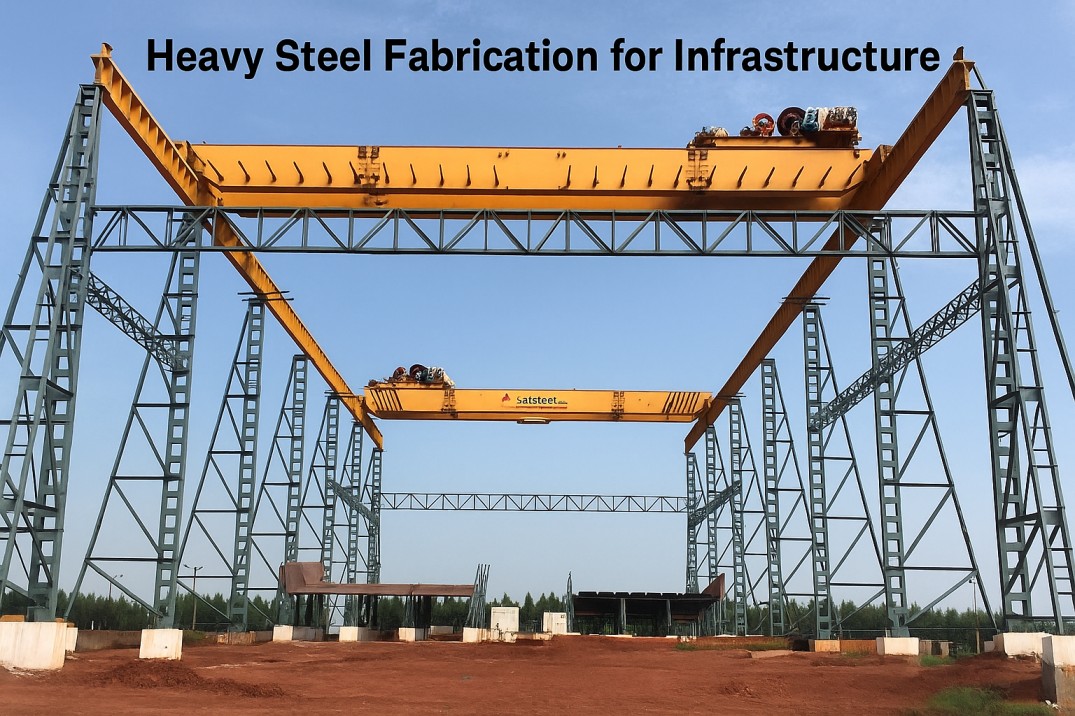Heavy Steel Structures for Bridges, Towers and Girders: The Backbone of Infrastructure

In the realm of modern infrastructure, steel has long been a preferred material for building bridges, towers and girders. These heavy steel structures play a pivotal role in the overall stability and functionality of major civil engineering projects. Whether used for pre-engineered heavy steel buildings, transmission towers or critical components in bridges, steel’s durability, strength and versatility make it an indispensable material for the backbone of infrastructure.
The heavy engineering structure work that involves designing and constructing steel structures for bridges, towers and girders must meet strict performance, safety and durability standards. This article explores the importance of heavy steel structures and how they serve as the foundational components of infrastructure projects, particularly in the creation of bridges, towers and girders.
Heavy Steel Structures in Bridge Construction
Bridges are integral to connecting various parts of cities, regions and countries. Steel’s ability to provide strength while maintaining a manageable weight makes it the perfect choice for building bridge girders and other load-bearing components. From highway overpasses to expansive railway bridges, steel structures offer both performance and efficiency. Here’s why heavy steel structures are indispensable in bridge construction:
High Load-Bearing Capacity
Steel bridge girders are designed to handle immense loads, including the dynamic pressures exerted by vehicles, trains and pedestrians. The tensile strength of steel allows for the creation of long-span bridge girders that support these massive loads without significant deformation.
Long-Term Durability
Steel bridges are designed to withstand harsh environmental conditions, such as heavy rainfall, snow and extreme temperatures. Properly protected against corrosion with coatings such as galvanizing or epoxy-based systems, steel structures ensure that bridges retain their integrity over time, reducing maintenance costs and extending their lifespan.
Design Flexibility
The ability to mold steel into complex shapes allows for the design of aesthetically pleasing yet functional bridges. Whether it’s pre-engineered steel buildings for short spans or massive steel structure buildings for longer spans, steel’s versatility enables the creation of bridges with various forms and functions.
Efficient Construction Timeframes
Prefabricated steel bridge girders can be manufactured off-site and transported for quick assembly at the bridge construction location. This streamlined process drastically reduces construction time compared to traditional methods, leading to faster project completion.
Steel Towers: Essential for Power Transmission and Communication
Steel towers are fundamental in supporting communication and power infrastructure. From telecommunication towers to transmission towers, these structures carry the weight of heavy cables, antennas and other equipment. Given the high demands placed on steel towers, they must be engineered to provide reliable support while withstanding environmental forces.
Power Transmission Towers
PEB steel structures are used for constructing transmission towers that support high-voltage power lines. These steel structures must endure the forces exerted by the weight of cables and external factors such as wind, snow and seismic activity. Steel offers exceptional strength and resistance to the elements, ensuring the long-term stability of power grids.
Telecommunication Towers
Telecom towers are essential for ensuring reliable communication networks. Steel is used to construct these towers because of its durability and the ability to hold communication equipment, such as antennas and radar, securely in place. These structures can also be designed to handle high wind loads and extreme temperatures, making them suitable for use in a variety of environments.
Design Flexibility
Steel structures allow for flexibility in design, whether for angular or tubular configurations. This versatility ensures that steel transmission towers and telecom towers can be customized to meet specific height, load and functionality requirements, making them adaptable for a variety of applications across different industries.
Longevity and Low Maintenance
Steel towers are inherently resistant to corrosion, particularly when galvanized or coated with protective finishes. This resistance ensures that steel structure require minimal maintenance over the years, contributing to their long-term performance. Additionally, the strength of steel helps these structures withstand the stresses of wind, weight and movement, reducing the risk of structural failure.

The Role of Heavy Steel Girders in Industrial and Civil Infrastructure
Girders are essential components in heavy engineering structure work, supporting the weight of bridges, overpasses and industrial buildings. Steel girders are designed to bear significant loads, making them indispensable in large-scale infrastructure projects. From industrial girders to those used in multi-story buildings, steel structures play a crucial role in ensuring stability and load-bearing capacity.
High Load-Bearing and Span Capabilities
Steel girders offer the strength required to bear the weight of both the structure itself and the loads it supports. Whether it’s a steel structure building in an industrial facility or a bridge girder in a large civil engineering project, steel girders provide the necessary support for heavy machinery, traffic and equipment.
Customizable Designs
Steel’s inherent flexibility allows for customized designs tailored to the specific needs of a project. Whether it’s for a multi-story steel structure or a custom-built girder, steel structures can be designed to meet the exact requirements of the project, ensuring optimal load distribution and durability.
Efficient Construction
Similar to pre-engineered heavy steel buildings, steel girders can be prefabricated off-site and assembled on-site, reducing construction time and improving efficiency. This allows for faster project delivery and minimizes disruptions to ongoing operations.
Durability and Maintenance
The longevity of steel girders is one of the key reasons why steel is used extensively in heavy civil and industrial projects. Steel is resistant to corrosion, decay and other environmental factors, ensuring the girder’s performance over time.
The Advantages of Heavy Steel Structures for Infrastructure Projects
The Advantages of Heavy Steel Structures for Infrastructure Projects
Exceptional Strength and Durability
Steel structures are renowned for their strength, which allows them to support large amounts of weight and withstand the forces they encounter over time. Whether it’s the weight of vehicles on a bridge or the load from power lines, steel provides the necessary support without compromising safety.
Cost-Effectiveness and Speed
Heavy steel structure work allows for faster construction times due to the prefabrication of components and the ease of assembly. This not only saves time but also reduces labor and material costs, making steel a cost-effective option for large-scale infrastructure projects.
Design Flexibility
The adaptability of steel structures allows for the creation of unique designs and shapes that would be difficult to achieve with other materials. This flexibility in design is particularly useful in projects where aesthetics and functionality need to be balanced.
Environmental Resistance
Steel’s resistance to environmental factors, such as corrosion, extreme weather and high-impact forces, makes it an ideal material for infrastructure projects that will be exposed to the elements.
Conclusion
Heavy steel structures are the backbone of modern infrastructure, providing the strength, durability and efficiency needed for critical projects like bridges, towers and girders. The use of pre-engineered heavy steel buildings in these applications ensures that the structures can handle immense loads, resist environmental damage and provide long-lasting support. From steel transmission towers to multi-story steel structures, the role of steel in infrastructure development is undeniable.
As infrastructure projects become more complex and demanding, the need for steel structures that combine strength, flexibility and efficiency will only increase. By choosing steel structure buildings and PEB steel structures, engineers and contractors can ensure that their projects meet the rigorous demands of modern infrastructure, providing safe, reliable and durable solutions for the future.
FAQs About Heavy Steel Structures

Founder & CEO
Mukesh Patel is the Founder & CEO of Build Matt ltd, specializing in Pre-Engineered Buildings (PEB) and general steel fabrication. With advanced technology, modern machinery, and a skilled workforce, he delivers efficient and high-quality solutions across East and Central Africa, including Uganda, Kenya, Tanzania, Congo, South Sudan, Rwanda, and Burundi.
- CNC Plasma Cut Decorative Metal Panels: Revolutionizing Interior and Exterior Design
- Combining Roof Vents and Translucent Sheets for Better Airflow and Natural Lighting in Uganda Cities
- Top Design Trends in Steel Staircases for Modern Ugandan Buildings
- Steel Railings & Balustrades for Uganda Cities
- Modern Steel Silos & Hoppers : Transforming Grain Storage Efficiency in Uganda






